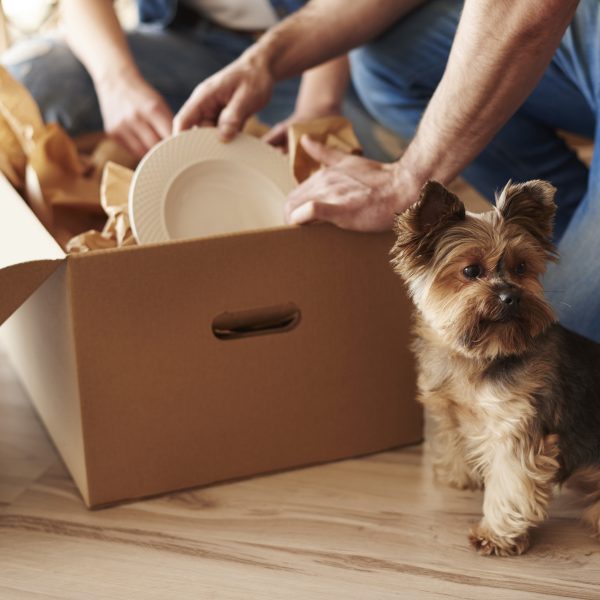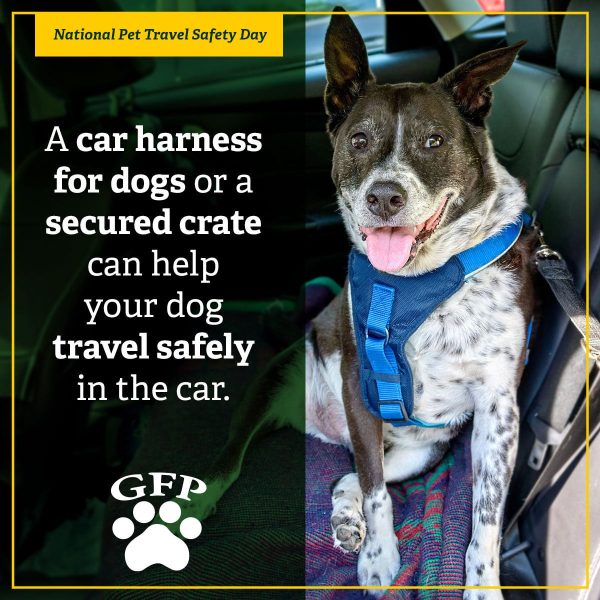5 Tips for Moving with a Dog
 Moving tends to be a busy and stressful experience for all involved. It can be particularly stressful for your dog. Here are some tips for moving with a dog to make the process a little easier:
Moving tends to be a busy and stressful experience for all involved. It can be particularly stressful for your dog. Here are some tips for moving with a dog to make the process a little easier:
1. Keep Changes Subtle and Routines in Place
Your dog is a creature of habit. In the midst of moving, try to keep your dog’s routines in place as much as possible. Having that familiarity and consistency will help them feel more comfortable and secure during the process.
Plus, this can help cut down on any tantrums or undesirable behaviors. Moving is complicated enough without adding a misbehaving dog into the mix.
If you can, try to complete the packing process over time. This keeps the changes to your dog’s environment slower and more subtle, giving them time to readjust. It could help keep your pup calmer, instead of getting overwhelmed by all the packing. With moving, you don’t always have a lot of time.
So, if you’re on a shorter deadline and have to pack up in a hurry, try to save the room your dog spends the most time in for last. While you pack other rooms up in a whirlwind, you can make slower progress on this room until everything else is done. This provides a safe space for your dog and one they are familiar with, which may help them handle the changes elsewhere a little bit better.
2. Update Records and IDs
Before moving, take your dog to the vet for a checkup. This ensures that they are in good health for the move and that their records are up to date. If you’re moving far enough away that you need a new veterinarian and you already know where you’ll be going, you can also authorize a records transfer and get a copy of your dog’s records for your own files as a backup. Keeping a copy of these records accessible while you are moving is a good idea as well. Make sure your dog’s IDs and tags are updated with your new information before you leave.
3. Secure Your Dog During the Move
On the day of the move, people will be in and out of your house and things will be moving everywhere. It’ll be stressful for your dog and it’s important that they stay out of the way and safe. If you have family nearby that your dog is familiar with, see if they would be able to take them for the day.
Another option is to secure them in a dedicated room of your home where they will be away from the noise and activity. If that’s not possible, or it would stress out your dog too much, you can also board them at a kennel or a doggie daycare until it’s over.
Once your old house is empty, you’ll be on your way to your new home. If this requires a long car trip, make sure you pack plenty of food, snacks, and water for both you and your pup. You’ll also want to bring some items that are familiar to your dog, like their favorite blanket or a comforting toy.
Their crate, a leash, a backup leash, medical records, and anything else your dog may need while traveling are also good items to have on hand. Other than that, it’s important to keep your dog safe during the trip. A car harness can keep them safe while traveling in the car. Planning your trip ahead of time and using dog-friendly travel guides to identify dog-friendly hotels will also be a big help during the move.
4. Slowly Acclimate Your Dog to the New Home
You may be tempted to let your dog run free once you get to your new home, but it’s best to let them get used to it first. They’ll be in a completely new environment that they’ll need to get used to. You will definitely want to take them for a long walk once you get to your new home to let them stretch their legs. After that, you’ll want to find a safe place to secure them while you’re moving in. This could be a room in your new home or a kennel or doggie daycare.
Once the flurry of activity dies down, you can expand your dog’s roaming space to a few rooms. Much like when you brought them home as a puppy, it’s best to slowly introduce them and get your dog used to your new home. Plus, you want to make sure your home has been dog-proofed and all vulnerable items have been unpacked before you let your dog loose in your home.
They’ll want to explore everything, which can be overwhelming. As they get used to their new home, you’ll also want to help your dog get used to their new neighborhood too. Long walks around the neighborhood with plenty of time to sniff and explore will help your dog become more familiar with their new surroundings.
5. Get Back Into Routines
Your pup will appreciate a quick return to the routines they’re used to. You can help with some of this by setting things up as consistently as possible in the new home. For example, if your dog’s crate and food bowls were in the living room of your old home, place them in the living room of your new home as well.
If your dog was previously walked during certain times of the day, try to get back on that schedule as quickly as possible. Having familiar routines in place can help your dog feel more comfortable and confident as they get used to their new environment.
Moving can be stressful and is often even more so with a pet involved. With these tips for moving with a dog, hopefully, the process is a little easier and less stressful for everyone involved.
Check out this infographic from Hire A Helper for more tips on moving with pets and helping pets adjust to a new home. Click to view it at full size.


